Despite my interest in the lore of the Cthulhu Mythos, I realized that I didn’t really know much about the various gods of that pantheon and their relationships to each other. After some research, here is what you need to know to make sense of these bizarre beings.
There are three sets of gods in the Mythos. The Elder Gods are the creator gods, indifferently benign towards their creation. The Outer Gods are the first created beings of cosmic size and scope. The Great Old Ones are the progeny of the Outer Gods who rebelled and were placed in slumber on Earth.
What is confusing about these classifications is there is not a strong consensus over their accuracy. If you have ever read the foundational works of the Mythos, the writings of HP Lovecraft and others, they read like the writings of a madman. But that is the point of this fiction.
The writings do not have an omniscient narrator, but are told as the writings or journals of persons who have been exposed to the mind-bending, sanity-breaking truths of the Mythos. This means the narrator, whether first or third person, is inherently unreliable.
Later writers, like August Derleth and scholars like Robert Price have tried to make sense of these beings in their works. While there is general agreement over the Great Old Ones and the Outer Gods, it is the Elder Gods and their role in the Mythos that is controversial.
Outer Gods
The Outer Gods are truly cosmic in scope. These are the gods of the stars and the outer darkness. They influence events on earth from the void between the stars and may even exist beyond four known dimensions. One way they influence and communicate with their mortal followers is through dreams and the Dreamlands.
Azathoth
[O]utside the ordered universe [is] that amorphous blight of nethermost confusion which blasphemes and bubbles at the center of all infinity—the boundless daemon sultan Azathoth, whose name no lips dare speak aloud, and who gnaws hungrily in inconceivable, unlighted chambers beyond time and space amidst the muffled, maddening beating of vile drums and the thin monotonous whine of accursed flutes.
HP Lovecraft, The Dream-Quest of Unknown Kadath
Azathoth is the proto-typical Mythos god, in every sense of that term. Azathoth is an indescribable being, with each mortal beholding it, perceiving its mind-bending form. It is also either the King or Co-King of the Outer Gods.
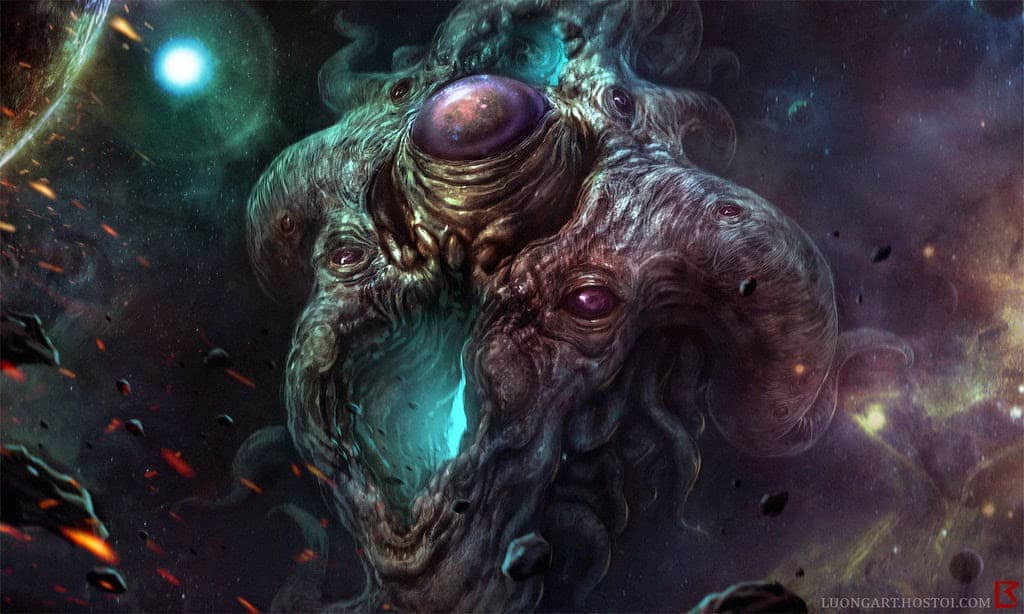
The flutes and drums are played by other, lesser outer gods for the sole purpose of keeping Azathoth in its slumber at the center of the universe. If Azzathoth were to awaken, it would destroy all existence in its hunger.
According to the writings of the author Ramsey Cambpell, Azathoth’s original followers was a race of insect creatures on the planet Shaggai. Upon destruction of their planet, they transported a temple to Azathoth to the Earth outside the town of Goatswood. With the help of human cultists, they perform obscene rites to Azathoth.
Magnum Innominandum
Also called The Nameless Mist, it is the creation of Azathoth. Along with its sibling, The Eternal Darkness, they are oldest of the Outer Gods, except for Azathoth. It is known for manipulating reality, acausation, and tampering with space-time.
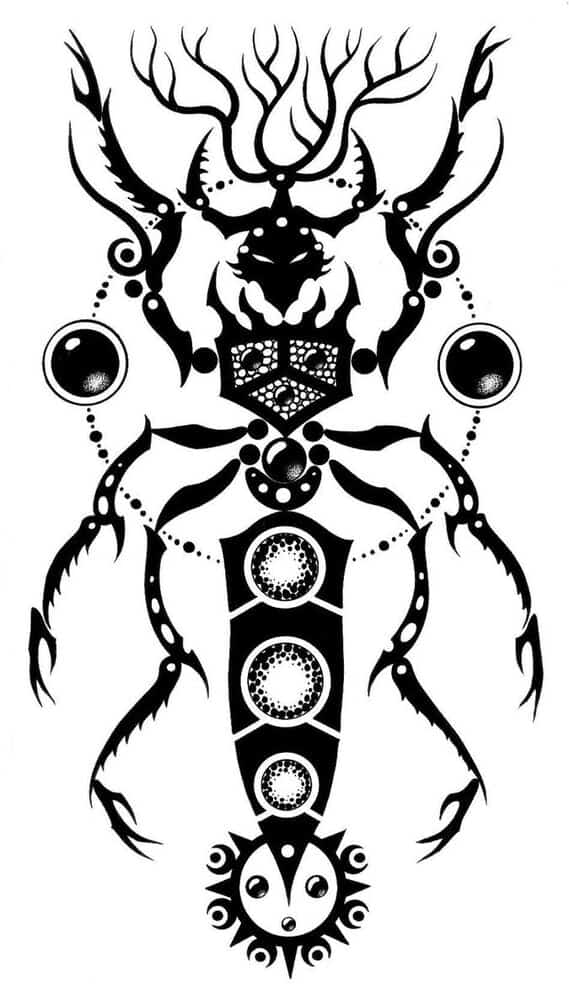
Nyarlathotep
Nyarlathetop is the messenger of the Outer Gods. Also called The Crawling Chaos, it is one of the few Outer Gods to take human form and walk on Earth. It is neither exiled to the outer cosmos nor forced into the dreaming.
Where the Other Gods and the Great Old Ones have their own language, Nyarlathetop can speak many human languages. He does not serve any one deity, but assists the human cultists of any Outer God. He most commonly appears like an ancient Pharaoh, but he can take any form.
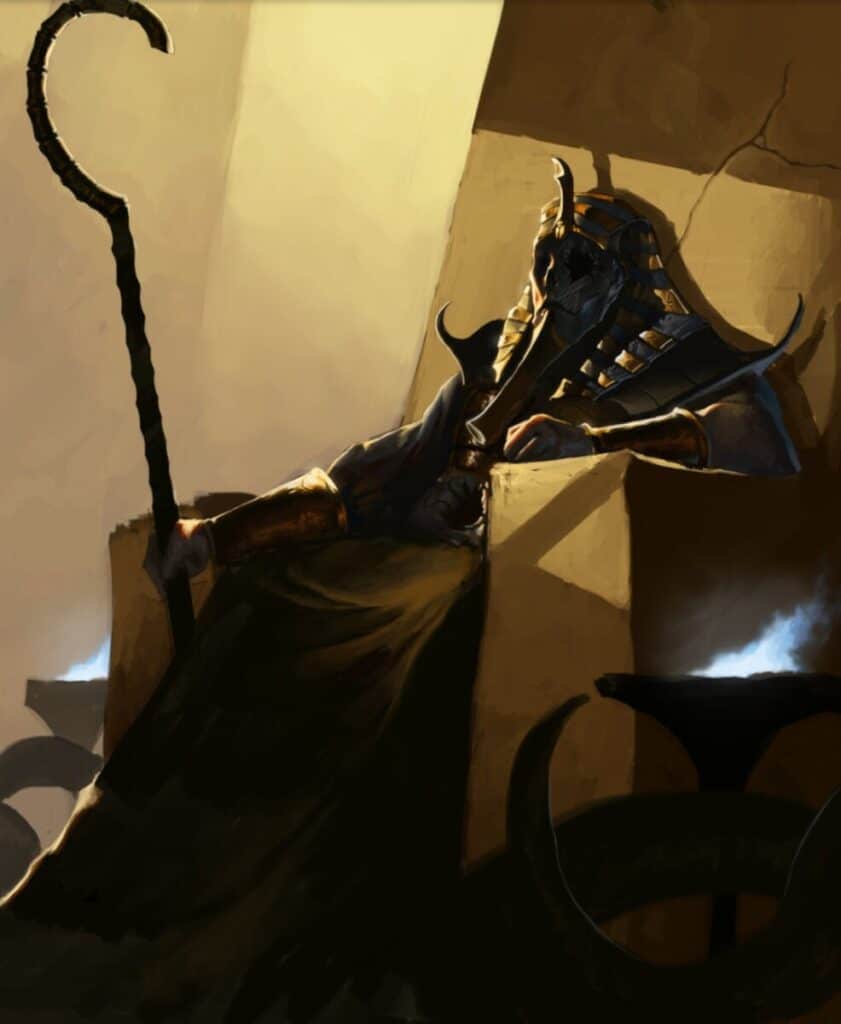
Nyarlathotep is more interested in spreading the madness of the Outer Gods than bringing about destruction. As such, he can be the ultimate antagonist of Mythos fiction or a Call of Cthulhu Campaign.
Shub-Niggurath
Also called The Black Goat of the Woods with a Thousand Young. Unlike some of the other Outer Gods, she is given a gender. Her role in the pantheon is as a fertility deity, although one of cosmic horror.
While Nyarlathotep is helping many different cults, Shub-Niggurath is worshipped by a large variety of different cultists in various places. Her cults tend towards what we would think of as dark druids or dark age cults out beyond the edge of shrinking civilization.
It is also believe that she has mated with many of the other Outer Gods to produce many vile, lesser (but still powerful) godlings.
Yog-Sothoth
Is said to be the brother or co-King to Azathoth. Yog-Sothoth is the being responsible for the establishment of time. It is omniscient because it is locked outside of the known universe. As such, many cultists call to it for knowledge.
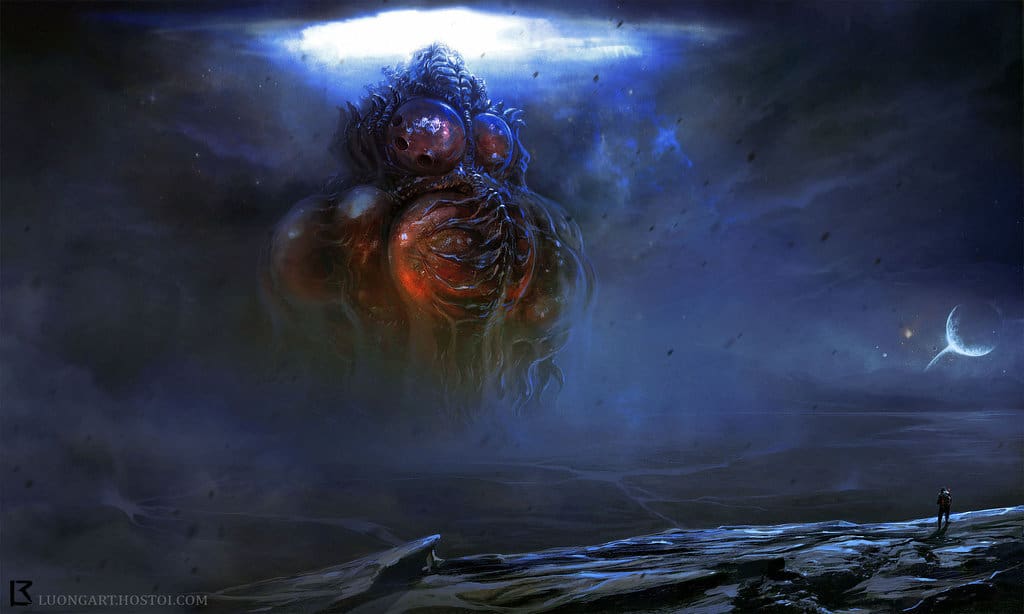
Yog-Sothoth knows the gate. Yog-Sothoth is the gate. Yog-Sothoth is the key and guardian of the gate. Past, present, future, all are one in Yog-Sothoth. He knows where the Old Ones broke through of old, and where They shall break through again. He knows where They have trod earth’s fields, and where They still tread them, and why no one can behold Them as They tread.
HP Lovecraft, The Dunwich Horror
It is the progenitor of Cthulhu and Hastur, the Yellow King. Its body is composed of thirteen iridescent globes.
Great Old Ones
These are the children of the Outer Gods. Several slumber on Earth or on other planets in the universe. They call out to people in their dreams, hoping to drive such people mad enough to wake them. Not all Great Old Ones are bound to a terrestrial planet. Some, like Hastur, travel through the cosmos and have several avatars.
Byatis
Byatis is a giant toad-like being with a single eye, crab-like claws and snake-like tentacles erupting from its face. It is claimed to be a god of forgetfulness, locked away behind a stone door on the British Isles since before the time of the Romans.
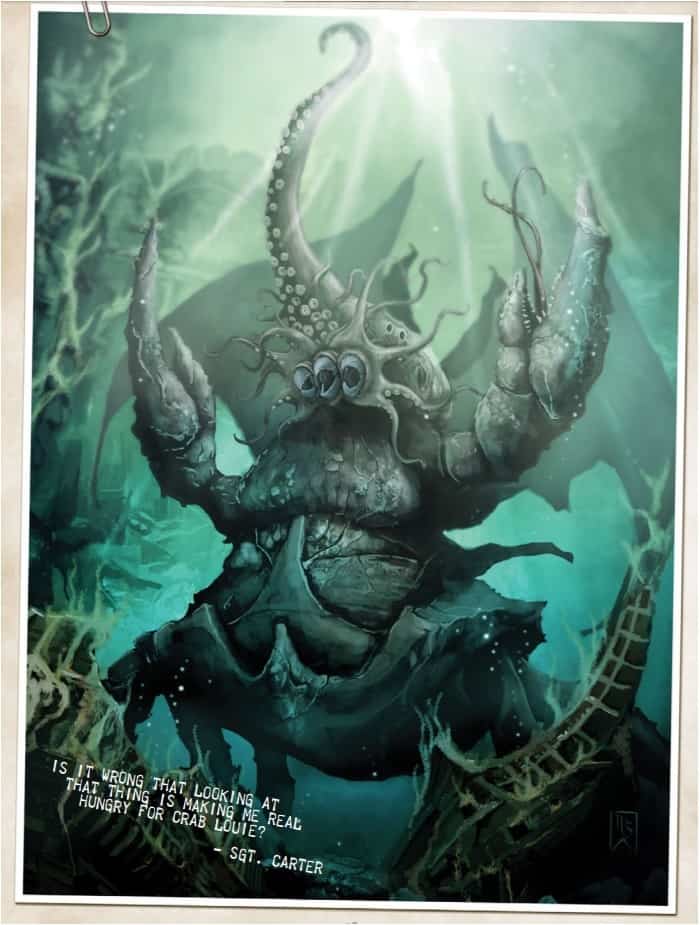
It is not clear who or what imprisoned Byatis, but maybe it was the Elder Gods.
Atlach-Nacha
A spider-god with a human-like face, it resides in the ruins of the Arctic kingdom of Hyberborea. The webs of its lair form a bridge between the waking world and the Dreamlands.
Cthulhu
Cthulhu sleeps under the Pacific Ocean in its city of R’lyeh. It appears in peoples dreams, often leading them to craft statutes, drawings and other artifacts depicting this being. These objects then become an idol or object of worship by cultists of Cthulhu.

Its cultists has cells throughout the world, but they are most often found on islands or near an ocean. They often chant “Ph’nglui mglw’nafh Cthulhu R’lyeh wgah’nagl fhtagn,” which translates as “In his house at R’lyeh dead C’thulhu waits dreaming.”
Cthulhu is of immense size, with great clawed hands, octopus tentacles around its mouth, and stubby, bat-like wings. It is believe that Cthulhu and its spawn came to earth, pre-dating the rise of man.
Dagon
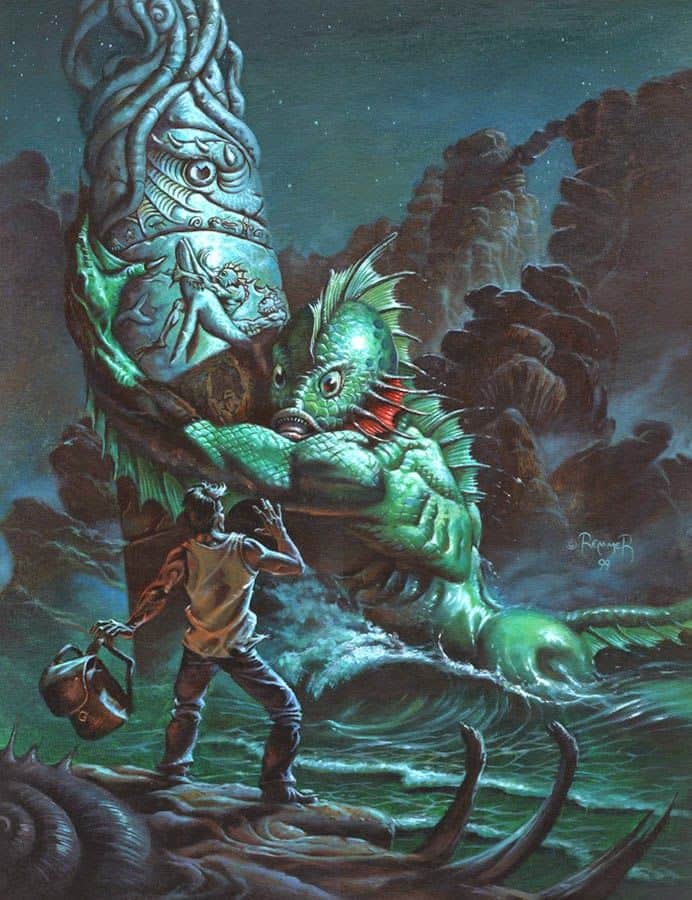
The Elder Deep One, that has grown to 50-feet in size, Dagon is also Consort to Mother Hydra. Dagon then leads the cult of Cthulhu as the Deep Ones are a non-human species that worship it. This is the same Dagon worshipped by the Biblical Philistines.
Ghatanothoa
The first spawn of Cthulhu, its appearance is so disturbing that seeing it or even a replica of it petrifies the viewer. The petrification is not to stone, but into a mummy-like leather, which preserves the organs, especially the victim’s brain. The victim is aware of its circumstance, but unable to move.
Only through some form of magic or destruction of the brain (which kills it) is the victim granted a release. Such magic will not restore the creature’s mind.
Hastur
The King in Yellow, the Feaster from Afar, is the half-brother of Cthulhu. While his true form is amorphous, it will sometimes appear as a flying monstrosity with razer-tipped talons. Other times, its avatar will be a cowled, yellow-cloaked being.
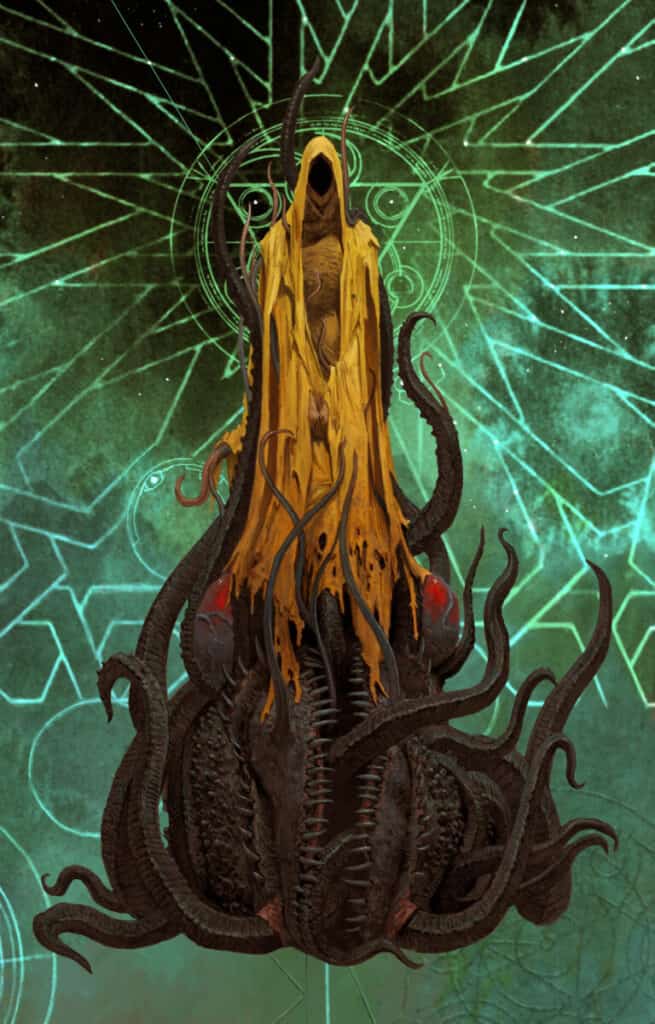
He is associated with the city of Carcosa and is heralded by the Yellow Sign. Carcosa is an extraterrestial city featured in the French play the King in Yellow. Within the Mythos, this play has been banned in France and any copies of which are sought and destroyed. To even read the play is to invite madness.
Iod
Worshipped by the Antlanteans, Iod is a crystalline fungus being. It paralyzes and consumes beings, only leaving their brains behind. Those brains are then incorporated into the body of Iod.
Nug and Yeb
Born of the pairing of Yog-Sothoth and Shub-Niggurath. Nug is the parent of Cthulhu. Yeb, the parent of Tsathoggua. At 10 feet in diameter, Nug and Yeb are small for Great Old Ones.
It is not clear their role in the Mythos. Some texts suggest they are to clear the earth to make way for the Great Old Ones. Other texts suggest they keep the garden of Yig.
Rhan-Tegoth
The last Great Old One to sleep, it inhabited modern-day Alaska. It is a 15 foot medusa-like, insectoid amphibious god-being. Its body was found and placed in various museums, causing chaos and insanity in its wake.
Tsathoggua
You shall know Tsathoggua by his great girth and his batlike furriness and the look of a sleepy black toad which he has eternally. He will rise not from his place, even in the ravening of hunger, but will wait in divine slothfulness for the sacrifice.
Clark Ashton Smith, The Seven Geases
Where Cthulhu sleeps in the sea, Tsathoggua sleeps deep underground in a lost cavern. When it wakes, it will devour whatever is present. Therefore, whoever wakes it best have a living sacrifice to feed it instead.

Its will is carried out by its formless spawn, a black goo. The spawn can take any shape and are very resilient. They can be found in basins of vases within Tsathoggua’s temple reading to kill the non-believers.
Yig
The Father of Serpents. Worshipped by Mesoamericans and the Native Americans of the Southern Plains, it sees itself as the protector of its children. It is believed that it would enter a frenzy of feeding every fall.
Elder Gods
As mentioned above, who the Elder Gods are, the relationship to the Outer Gods and Great Old Ones is not well developed within the Mythos fiction. The early authors simply had god-like beings that were helpful or protective of the story’s protagonist. Later authors used that to write additional beings who were not indifferent to human existence.
However, the purpose of the Elder Gods, beyond just reducing the influence or stopping the cults of the Outer Gods, is not well understood. In that way, they are as inscrutable as the other powerful beings in the universe. It is equally possible they are also Outer Gods, but who merely acknowledge humanity’s existence and wish for it to continue.
A common theme of the Elder Gods is they were worshipped by various human cultures through the millenia. This suggests their oppositional purpose to the Great Old Ones and Outer Gods. The Elder Gods at least wish to protect their worshippers, but these other beings simply destroy because of their indifference to their human worshippers.
Bast
The ancient Eyptian goddess of cats is worshipped by all cats, everywhere, on all planets and in the Dreamlands. She is also associated with ghouls, because cats also eat the dead.
If you want to create fiction or a roleplaying game scenario, cats could protect the protagonists. They could scare off supernatural entities or creatures. Or they could lead the party away from danger.
Hypnos
The Greek god of sleep and dreams. Hypnos is depicted in HP Lovecraft’s story of the same name as a god who educates the protagonist about the dimensions beyond space and time within the Dreaming. Hypnos can be a being who helps protagonists in the Dreamland. He may even teach them how to get around while dreaming.
Nodens
Within the Mythos, Nodens eventually became the leader or the head of the Elder Gods. He is master of the night-gaunts. These are creatures of the Dreamlands, with smooth, whale-like skin, an elongated faceless skull, and bat wings. Nodens, like most of the Elder Gods, helps those in the Dreamlands as depicted in the HP Lovecraft work Dream-Quest of Unknown Kadath. His purpose for doing so is inscrutable.
On Earth, he was a Nordic and Celtic deity of the hunt. But there was more of an element of catching or trapping.
Final Thoughts
Of course, my primary focus and thoughts on researching and describing the gods of the Cthulhu Mythos is how to use them within a game. If the player characters directly interact with any of the Outer Gods or Great Old Ones, you’re either at the culmination of the story arc, your player characters made some poor choices (maybe in a fit of insanity), or they rolled really badly.
The other problem is that these various gods are largely interchangeable with each other. They either have a describable form (usually an amalgam of other creature) or an indescribable form. But trying to describe the various indescribable forms may cause the players to mix them together.
Also, with notable exceptions, these beings are without purpose. They are indifferent to your party’s existence. Like all great nihilistic horrors, humanity’s death is brought about by cosmic indifference like us stepping on bugs, rather than cruel intention. This makes it hard to use these ineffable beings as our antagonists.
The exceptions are those with at least some personality: Nyarlathotep Hastur are the two examples, but maybe only because they at least have some semblance of human form.
The real stories here are the stories of the cultists. What lead them to worship such vile, ineffable beings indifferent to their existence? What do they hope to achieve with their rituals? Power? Aren’t there better ways, less dangerous ways of getting that power? Are they so desperate within their society, so downtrodden that this is the only way out?
Finally, they may just hate existence so much that they do want these beings to snuff it out. Performing these rituals is a cruel and complex method of suicide by cop. When telling these stories, it is the human element that will draw in your readers and players. It is the hard choices of using the mind-bending power of these beings to stop the other beings. But you risk your own sanity and becoming your own cult leader seeking power and destruction.
Here are some links to where you can get games that play in this universe, and others, which can be found over here.
If you want to explore the wilder (and wider) world of tabletop roleplaying games go there! If you want to start to learn on how to paint miniatures, click already! Or maybe you want to read more of my posts about Dungeons and Dragons, then click away here!

